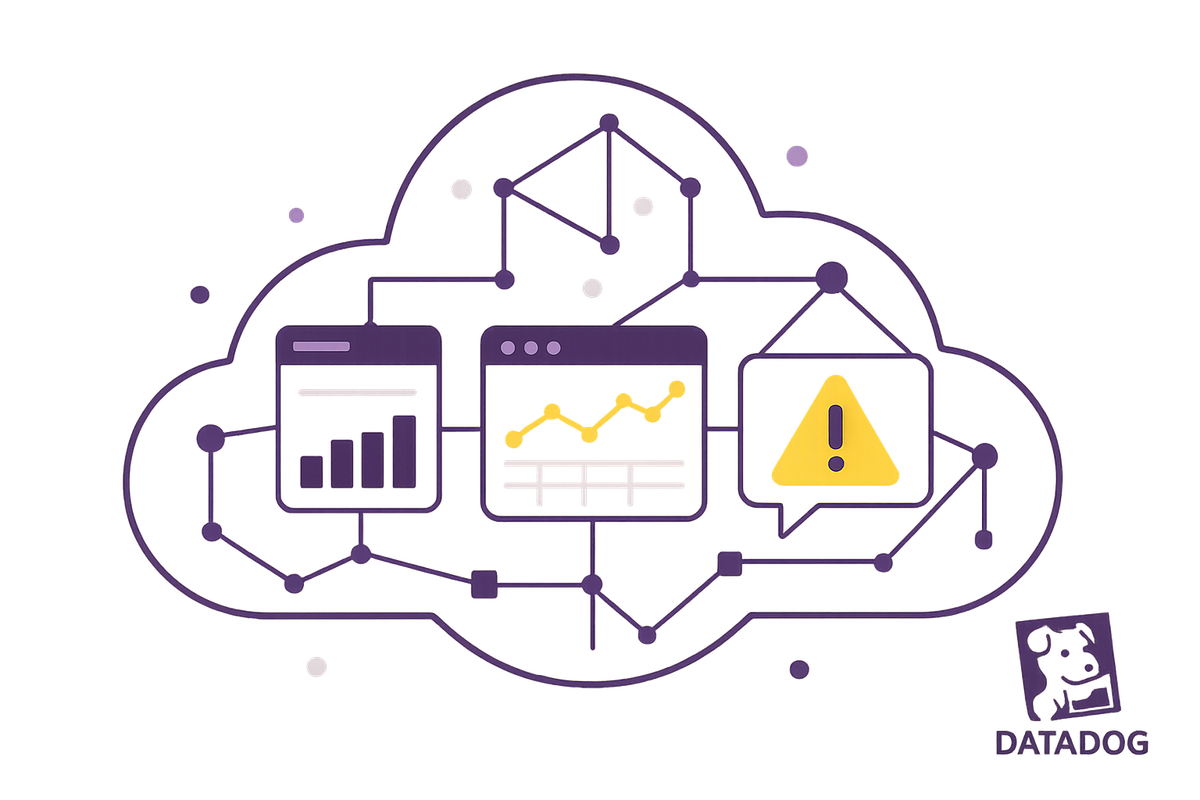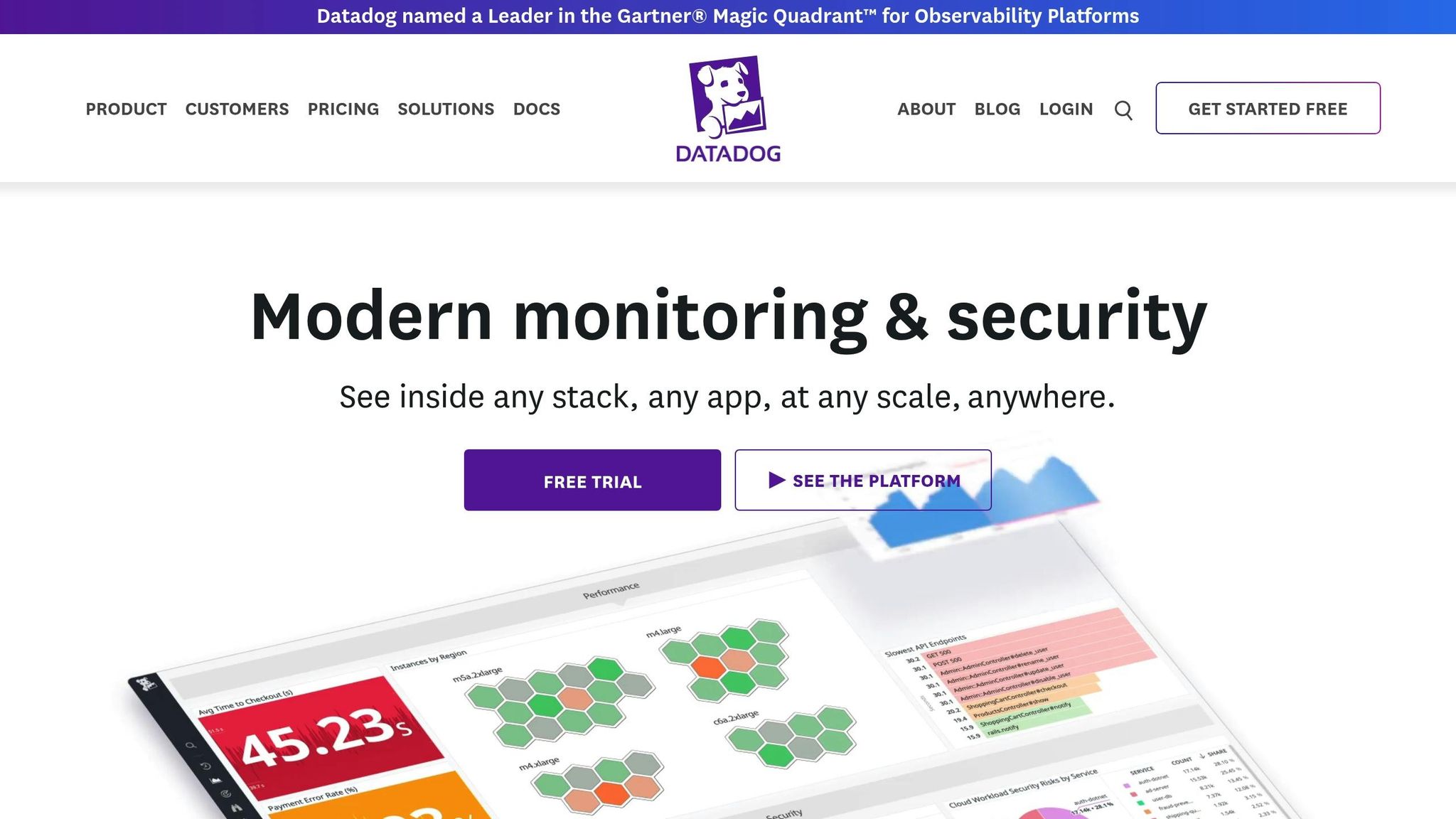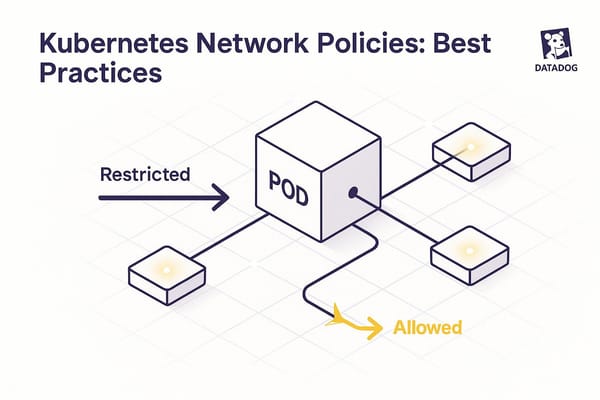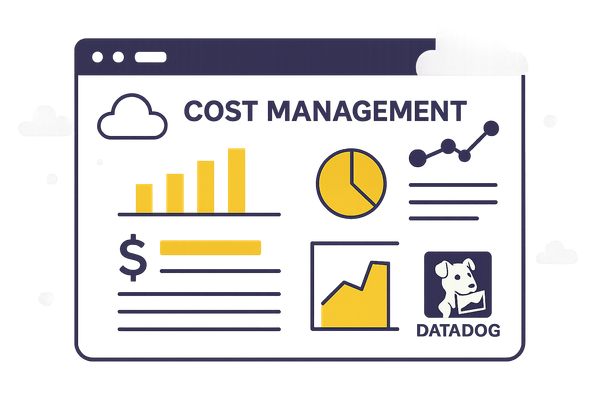How to Manage Cloud Risk with Datadog
Simplify cloud risk management with tools for monitoring, prioritizing, and fixing security and compliance issues in one platform.

Managing cloud risks can feel overwhelming, especially for small and medium-sized businesses (SMBs). But Datadog simplifies this process by offering tools to monitor, prioritize, and fix security and compliance issues in one platform. Here’s how it works:
- Connect to Cloud Providers: Link Datadog with platforms like AWS, Azure, or Google Cloud to gather security data.
- Enable Security Features: Use tools to detect vulnerabilities, misconfigurations, and compliance gaps.
- Rank Risks by Severity: Datadog uses scoring systems to prioritize threats, so you know what to tackle first.
- Fix Issues: Assign tasks, automate responses, and track progress with integrated tools like Jira.
- Ensure Compliance: Monitor frameworks like SOC 2, HIPAA, and GDPR in real time, and generate custom reports for audits.
Datadog helps SMBs stay secure, compliant, and efficient by addressing risks before they escalate. Let’s dive into the details of how it works.
Datadog Cloud Security Management Demo

Setting Up Datadog for Cloud Risk Monitoring
To use Datadog for monitoring cloud risks, start by linking it to your cloud platforms and activating its security tools.
Connecting Datadog with Cloud Providers
Begin by integrating Datadog with your cloud infrastructure. Datadog works with major platforms like AWS, Azure, and Google Cloud Platform, letting you gather security data for analyzing risks. Each platform offers guided steps to securely grant Datadog access to your security logs.
For added convenience, you can integrate Single Sign-On (SSO) with your current identity provider. This simplifies access management by allowing your team to use existing authentication systems. Once your cloud connections are set up, you’re ready to activate Datadog’s security features.
Configuring Cloud Security Features
With your cloud providers connected, it’s time to enable and customize Datadog’s Cloud Security tools. These features let you address a range of risks, including vulnerabilities, misconfigurations, identity issues, and compliance gaps. Datadog supports both agentless and agent-based setups, giving you flexibility in how you monitor your environment.
Head to the Security section in the Datadog dashboard to turn on these features. This will provide detailed insights into your cloud security posture, helping you safeguard your systems more effectively.
Finding and Assessing Cloud Risks with Datadog
Once you've set up Datadog, the platform helps you actively identify and evaluate security risks in your cloud environment. After activation, Datadog automatically scans your cloud setup and highlights actionable threats, giving you a clear path to address them.
Using the Security Inbox and Dashboards
The Security Inbox acts as your main hub for managing cloud risks. It pulls together critical issues from Cloud and Application Security Management, providing detailed context for each risk. This includes information like public accessibility, privilege levels, known exploits, and data from logs, traces, and host activity. With this enriched data, you can quickly assess the potential impact of each threat.
The dashboard complements the Security Inbox, allowing you to filter and prioritize risks that affect production systems and high-traffic services. Its visual interface makes it easier to identify patterns and monitor trends in your security posture over time.
Ranking Risks by Severity
Datadog uses a structured approach to rank risks, assigning each one a severity level: Critical, High, Medium, or Low. This ranking is based on two key systems:
- Common Vulnerability Scoring System (CVSS) 3.1: For application and infrastructure vulnerabilities, Datadog uses this standard to calculate severity. It also enhances the base CVSS score by factoring in environmental and threat-specific metrics tailored to your infrastructure.
- Datadog Security Scoring Framework: For misconfigurations, identity risks, and attack paths, this proprietary system evaluates two main factors: how likely an attacker could exploit the issue and the potential damage it could cause.
The Security Inbox prioritizes findings by severity, followed by the number of correlated risks and additional contextual details. This ensures that the most dangerous and exploitable vulnerabilities rise to the top of your list, helping your team focus on the most urgent issues first.
Fixing Cloud Risks with Datadog
Once risks are ranked in the Security Inbox, the next step is crafting a solid plan to address vulnerabilities. With Datadog's tools, you can not only tackle these risks but also document every action taken, ensuring a clear and organized remediation process.
Creating a Fix Process
A consistent workflow for addressing security risks is essential for staying organized and tracking progress. Datadog's Security Signals feature provides the backbone for this process, offering a clear interface to investigate, assign, and resolve issues step by step.
When a signal is triggered, start by investigating it thoroughly. Use Datadog's correlated infrastructure data, logs, and user activity to separate genuine threats from false alarms. For instance, if unusual database access is flagged, cross-check it against recent application updates or scheduled maintenance to determine whether it's a real concern.
Assign responsibility for each signal to team members, and use comments to create an audit trail. To streamline this further, integrate Datadog with ticketing tools like Jira or ServiceNow, automating the creation of remediation tickets. Documenting the steps taken to resolve issues not only supports compliance but also speeds up responses to similar risks in the future.
Datadog also allows you to group related security signals into broader incidents. This is especially helpful when dealing with coordinated attacks or systemic issues affecting multiple resources. By linking related signals, you can monitor the overall progress of complex fixes and ensure no detail is overlooked.
Once you've solidified manual processes, you can take efficiency to the next level by automating routine responses.
Automating Responses for Faster Risk Fixes
Datadog's built-in workflows enable you to automate specific actions, such as disabling compromised accounts, rotating API keys, or isolating vulnerable servers, whenever certain threats are detected. Pair these workflows with automated remediation tools to implement real-time blocking measures. You can also configure alerts through channels like Slack, PagerDuty, or email, tailoring notifications based on the severity of each risk.
Start with straightforward automation, like sending alerts or creating tickets for low-risk issues. Gradually expand to more advanced actions, such as isolating resources or updating configurations. Always test these automated responses in non-production environments before rolling them out fully.
For strategies specifically designed for small and medium-sized businesses, check out our blog at Scaling with Datadog for SMBs.
Maintaining Compliance and Audit Readiness
Once you've set up automated responses and addressed immediate risks, the next step is ensuring your cloud environment aligns with regulatory standards. For small and medium-sized businesses (SMBs), compliance isn't just about avoiding fines - it’s also about establishing trust with customers and partners while simplifying the audit process.
Datadog takes the stress out of compliance by offering continuous monitoring and reporting tools. Instead of scrambling for evidence during audits, you’ll have year-round, real-time insights into your compliance status. This ongoing visibility integrates seamlessly with Datadog's compliance tracking and reporting features.
Tracking Compliance with Datadog
Datadog keeps a constant watch on your infrastructure to ensure it aligns with frameworks like SOC 2, HIPAA, PCI DSS, and GDPR. It automatically scans your cloud resources and flags any policy violations as they happen.
The Compliance Overview dashboard serves as a centralized hub, showing your compliance status across all monitored frameworks. It highlights which controls are passing, failing, or need attention, and includes trend data to help you tackle issues before they show up in an audit.
You can also tailor compliance frameworks and rules to fit your industry’s needs or your own internal policies. For instance, if your SMB operates in healthcare, you can set up rules to monitor patient data access, ensure encryption is in place, and log any unauthorized access attempts.
Security Signals add another layer of compliance tracking by automatically detecting and documenting security events that could affect your regulatory standing. These signals create a detailed audit trail, showing when incidents happened, how they were handled, and what actions were taken to resolve them. This documentation becomes incredibly valuable during audits, showcasing your organization’s dedication to security and incident management.
Creating Custom Compliance Reports
On top of real-time tracking, Datadog lets you generate detailed, custom compliance reports that simplify complex data.
Start by building compliance dashboards using Datadog's widget library. Use visual tools like time series graphs, tables, and heatmaps to highlight trends, violations, and insights into your environment.
Datadog's querying language allows you to filter and organize data specific to compliance controls or audit needs. This ensures your reports focus on exactly what auditors are looking for.
Template variables make reports dynamic, allowing you to filter by environment, team, or resource. This flexibility is especially helpful when different departments need to zero in on their specific compliance areas.
With the Scheduled Reports feature, you can automate compliance updates via email. Set up reports to go out weekly, monthly, or quarterly, ensuring everyone stays informed about your compliance status. This proactive communication demonstrates your ongoing commitment to meeting regulatory standards.
For more advanced needs, Datadog's Log Analytics API gives programmatic access to compliance data. This is ideal for integrating Datadog metrics into your existing business intelligence tools or creating custom reports that combine compliance data with other organizational insights.
When preparing for audits, you can create dashboards that directly map to the controls auditors will review. Add context and documentation to each dashboard, explaining how the metrics align with compliance requirements. This preparation can save significant time and make the audit process much smoother.
Conclusion: Ongoing Risk Management with Datadog
Staying ahead of cloud risks requires constant attention and a commitment to improvement. In this guide, we've explored how Datadog transforms cloud risk management into a proactive and organized process, helping SMBs keep their infrastructure secure and compliant.
Datadog offers real-time visibility into potential risks, enabling you to detect and prioritize threats before they escalate into major problems. This visibility not only helps you address risks promptly but also ensures you can prioritize fixes based on actual severity while maintaining a clear audit trail for compliance.
Automation takes these insights a step further by streamlining your response efforts. Automated workflows provide consistent and reliable reactions to security events, even when your team is juggling multiple responsibilities. For SMBs with limited IT resources, this consistency is invaluable, allowing you to focus on other priorities without compromising security.
Another standout feature of Datadog is its ability to scale effortlessly with your business. As your infrastructure grows, your compliance dashboards, security policies, and automated workflows adapt without requiring major overhauls. This means your security measures evolve alongside your business, keeping pace with your needs.
The key to long-term success lies in continuous improvement. Regularly reviewing your security posture, updating compliance frameworks, and fine-tuning automated responses ensures your risk management strategy stays aligned with new threats and business objectives. This ongoing cycle of optimization strengthens your cloud security over time, preventing it from becoming outdated.
For SMBs aiming to make the most of their Datadog investment, resources like Scaling with Datadog for SMBs offer tailored guidance and insights to address the unique challenges smaller organizations face in cloud risk management.
With Datadog as your foundation, your risk management strategy doesn't just keep up - it grows stronger with every update. You'll be ready to tackle security challenges head-on while maintaining the agility and efficiency that drive your business forward.
FAQs
How does Datadog evaluate and prioritize cloud security risks?
Datadog uses a scoring system to evaluate and rank cloud security risks. This system takes into account multiple factors, including severity levels (Critical, High, Medium, Low), threat activity, runtime context, and specific indicators like misconfigurations or identity risks. By analyzing these elements, Datadog ensures that risks are prioritized based on their potential impact and relevance.
This scoring method allows businesses to concentrate on addressing the most pressing vulnerabilities first. For small and medium-sized businesses (SMBs), this approach simplifies cloud management while helping maintain strong security measures.
How can Datadog's automated response features help SMBs manage cloud risks more effectively?
Datadog's automated response tools give small and medium-sized businesses (SMBs) the ability to tackle cloud risks with ease. With real-time threat detection and instant mitigation, SMBs can address security issues quickly, cutting down response times and reducing the risk of damage. This ensures a safer, more reliable cloud environment.
By spotting risky behaviors and misconfigurations automatically, Datadog helps SMBs strengthen their security without needing to invest in extensive manual processes. For businesses with limited resources, this approach is a game-changer. It reduces the reliance on large security teams while keeping operations running smoothly and staying compliant.
How does Datadog support compliance with standards like SOC 2, HIPAA, and GDPR, and how can it help prepare for audits?
Datadog supports businesses in meeting compliance standards such as SOC 2, HIPAA, and GDPR by providing tools that help monitor, document, and maintain alignment with regulatory requirements. Its compliance-focused features, combined with security certifications, help ensure the integrity of your cloud environment.
With the Audit Trail feature, you can track system activity, produce detailed logs, and generate reports that make audit preparation easier. These tools allow you to demonstrate compliance, simplify governance processes, and keep your systems secure while staying aligned with regulatory expectations.




